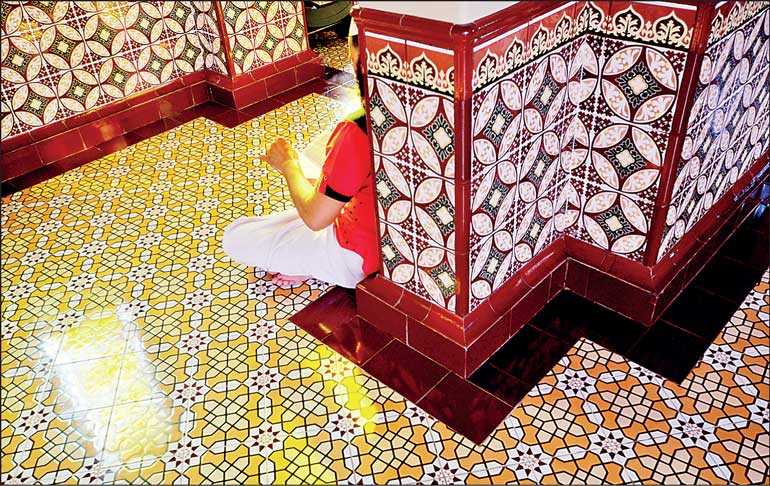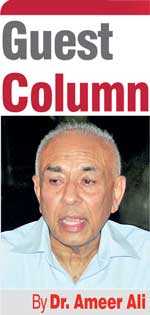Sunday Dec 14, 2025
Sunday Dec 14, 2025
Friday, 8 February 2019 00:00 - - {{hitsCtrl.values.hits}}

“It is a fact that when disputation and disagreement … on any topic have once risen among a people, it is not possible, after they have taken root, for that disputation and disagreement to be entirely eradicated … the intelligent man will not be so stupid as to hope to decide a dispute of such long standing.
The intelligent person contemplates and observes the wise purpose of disagreement … He finds that many benefits … lie within it – and does not interfere in or attack anybody’s tenets or disposition …” (KatibCelebi, Mizan-ul-haqq, as translated by Geoffrey Lewis, Balance of Truth, pp. 28 and 41 and quoted in Shahab Ahmed, What is Islam?, New Jersey: Princeton University Press, 2016, p. 277)
In one of my earlier pieces titled ‘Behind the Mawanella Bigotry II’ (9 January), I said, “Madrasas have an important role to play in character building of young Muslims. However, the curriculum of these religious schools needs modernisation.”
Beyond character building madrasas’ knowledge horizon has to be expanded to incorporate new developments in teaching and learning. I also referred in that piece to a book by Ebrahim Moosa, ‘What is a Madrasa?’ published by Edinburgh University Press, 2015. The author concludes his book with the following comments:
“… Knowledge does not only have to serve the purpose of salvation and bypass the realities of the world in which believers live and flourish. Both the revelatory tradition and the humanistic tradition of knowledge can be fruitfully harnessed, rather than one at the expense of the other. The metaphysical legacy of the past could have a fruitful dialogue with the scientific heritage of the present in order to create a new metaphysical theology. But to achieve that goal a robust exposure to multiple knowledge traditions is a precondition. A refurbished Muslim orthodoxy in South Asia can offer guidance to millions in an effective and realistic manner. Madrasas are the ideal social laboratories where these experiments with knowledge can successfully be undertaken.” (pp.252-253)
Madrasas (I am excluding the village maktabs from this category) in Sri Lanka have a history of more than one century and they are closely linked with those in the Indian subcontinent. This is why Moosa’s observations are particularly pertinent to Sri Lankan context. Also, his comments need serious consideration because he started his education in the traditional institutions of Darul Uloom Deoband and Darul Uloom Nadwatul Ulama in Lucknowb efore furthering his studies in modern universities and becoming an academic.
He is now a Professor of Islamic Studies at the Notre Dame University in USA. His knowledge about madrasa education is therefore not simply theoretical but mixed with practical experience. There are several others like him such as the Professor of Law, Khalid Abou El Fadl at UCLA School of Law, who is also calling for reforms in madrasa education.
Without the madrasas Sri Lankan Muslim community would have lost not only Islam’s theological legacy but also the practical side of din, which is a way of life and not religion in Western sense. It was the madrasas that produced and are producing mosque functionaries like imams who lead prayers and deliver sermons, muazzins who call for prayer and take care of mosque maintenance, and even school teachers who teach basic Islamic catechism to primary school children.
These imams, muazzins and teachers are the chief interlocutors who spread the revelatory message of Islam in the community. If mosques are the heart of the Muslim community, madrasas are its arteries. However, like in the subcontinent, and for that matter in most other parts of the world, the method of instruction and subjects taught in madrasas have remained traditional and without any change to keep pace with the intellectual progress of a techno-scientific age.
The madrasas are operating simply as transmitters of knowledge produced decades and even centuries ago rather than equipping their students with an intellectual armoury to confront challenges from a scientific modernity. Their preferred modality of teaching and learning has remained predominantly prescriptive and proscriptive rather than exploratory. It is repetitive and memory oriented rather than discursive and analytical.
It is this method of teaching and training that creates what Muhammad Arkoun calls amytho-historical mind as opposed to a tele-techno-scientific mind. A deeply inherent suspicion towards rational inquiry and scientific methodology with pure utilitarian approach towards modern technology has produced and calcified a metaphysical orthodoxy in which madrasa education has played a critical role. This orthodoxy is not only backward looking in outlook but also explosively reactive to heterodoxy. To deny this reality is to live in fools’ paradise. Thus, reforming and modernising madrasa education with a view to at least mellowing the orthodoxy is sine qua non. It is an imperative task facing Muslim educationists and Muslim activists in Sri Lanka.
I use the term paideia from ancient Greek culture to describe the model that I have in mind. Paideia refers to a well-rounded education to the children of Greek aristocracy. The scholars that madrasas produce, the ulema (plural of alim and is not restricted to religious scholars alone), are, in the context of Sri Lanka, a spiritual elite equivalent to an aristocracy in the mundane world.
Ulema have a special place and prestige among ordinary Muslims and they are the chief communicators through whom Islamic knowledge is transmitted to Muslim masses almost daily and through multiple channels. That ulema should therefore be intellectually versatile and equipped with a broader knowledge than pure theology moulded in the past, so that they can confidently involve creatively in what Shahab Ahmed calls(in a different context), “hermeneutical engagement”, with the rational, scientific and technological challenges of present times. Islam has a rich discursive epistemological tradition, which stagnated after the 12th century. It is by modernising and reforming the madrasas that we can revive that tradition and push forward.
Unlike Greek paideia, which had no place for theology or spiritual disciplines but included subjects in liberal arts, science and mathematics as well as martial arts and aesthetics, paideia of madrasas should include elements of those branches of knowledge with theological studies. It is a pity that madrasas are not even training their students to handle information technology.
Moosa, from whom I quoted above, cites a revealing episode from the life of the much maligned Mughal Emperor Aurangazeb who went through traditional education and studied subjects similar to the ones taught in today’s madrasas. One day, he chided one of his tutors Mullah Salih for not teaching him what was necessary for a ruler.
“If you had seasoned me with that philosophy which forms the mind to ratiocination, and intensely accustoms it to be satisfied with nothing but solid reasons, if you had given me those excellent precepts and doctrines which raise the soul above the assaults of fortune, and reduce her to unshakeable and always equal temper, and permit her not to be lifted by prosperity nor debased by adversity; if you had taken care to give me the knowledge of what we are and what are the first principles of things, and had assisted me in forming in my mind a fit idea of the greatness of the universe, and of the admirable order and motion of the parts thereof; if, I say, you had instilled into me this kind of philosophy, I should think myself incomparably more obliged to you than Alexander was to his Aristotle and believe it my duty to recompense you otherwise than he did him. Should not you, instead of your flattery, have taught me somewhat of that point so important to a king, which is, what the reciprocal duties are of a sovereign to his subjects and those of subjects to their sovereign; and ought not you have considered, that one day I should be obliged with the sword to dispute my life and tit (seize) crown with my brothers? … Have you ever taken any care to make me learn, what it is to besiege a town or to set an army in array? For these things I am obliged to others, not at all to you. Go and retire to the village whence you are come, and let nobody know who you are or what is become of you.” (This is only one part of a long quote Moosa had edited from the original by Francois Bernier in Travels in Mogul Empire A.D. 1656-1668.)
What is needed is a madrasa education grounded in the revelatory message of Islam but incorporates into its curriculum other branches of epistemology so that future generations of ulema who come out of it will be a class of enlightened teachers, preachers and community leaders behind whom all Muslims irrespective of inter-generational and inter-gender gaps would rally for guidance.
Yet, reforming madrasa education is not easy. There will be resistance from the conservatives and vested interests who may fear that their traditional fortresses would crumble in the face of changes. Radical changes will have no prospect of acceptance. Therefore, to make reforms more malleable, they can be introduced incrementally to allow the guardians of orthodoxy sufficient time to digest the impact of each dose before injecting the other. Irrespective of how one may implement this, without serious modernisation and reforms to bring about a new paideia the madrasas in operation now would remain largely disconnected to a fast changing techno-scientific world. Will Muslim leadership in the country including ACJU wake up and act?
(The writer is attached to the School of Business and Governance, Murdoch University, Western Australia.)